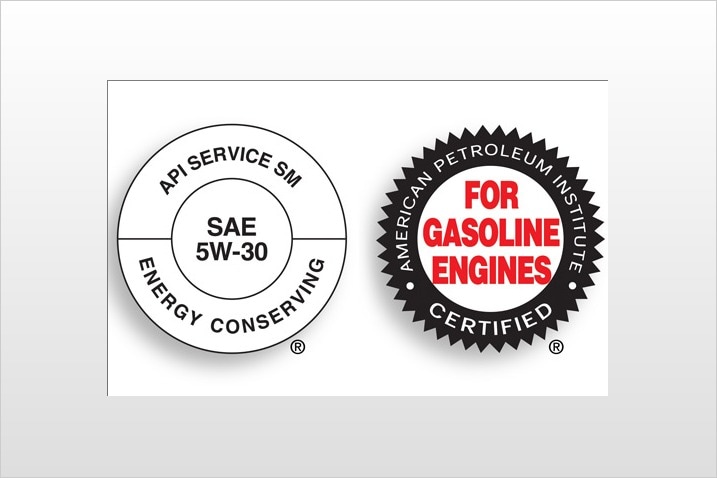Weight and Oil Viscosity
Oil is like pancake syrup. Without blending and additives, on cool days oil would be as thick (viscous) as Mrs. Butterworth's stored in the refrigerator. At high temperature, though, it would get uselessly thin, like microwaved syrup. Long ago, the Society of Automotive Engineers (SAE) developed a rating system for oil viscosity, the most basic of characteristics, which is often called weight. It's expressed by four or five characters, such as 10W-30. The lower the number before the W (for "winter"), the better it flows in cold temperatures. The number after the dash indicates how well the oil flows when it's warm. Higher numbers mean the oil is "heavier," or more viscous. Multi-viscosity oils developed several decades ago mean you don't have to worry about using different oils for winter and summer.
Don't select heavier-than-recommended oil in the mistaken belief it'll provide better protection. Old-timers are used to heavier oils, but many manufacturers currently specify light oil, such as 5W-20. One reason is that some modern engines have incredibly tight clearances between parts. Especially when the engine is cold, a heavier oil may not reach into these tight areas. The lighter oil also helps provide better fuel economy.
Certifications
Quality oils carry up to three certifications from three different organizations. Your owner's manual will say which standard is required. These certifications indicate that the oil met the testing and content requirements of these organizations. The most well-known is the American Petroleum Institute's (API) "starburst" and "donut." In the center of the API circle is the SAE weight (e.g. 10W-30). The outer ring will say "API SERVICE" followed by two letters: "SM" has been the top API rating since 2004, and API says it'll work in all automotive gasoline engines. The previous standard — "SJ" — was for 2004 and earlier model years. If the service rating starts with a "C," it's for diesel engines.
American and Japanese automakers combined to create the International Lubricant Standardization and Approval Committee (ILSAC). Its current standard is GF-4. A new standard, GF-5, is scheduled for 2010. Finally, some European cars require oil certified by the European Automobile Manufacturers' Association (ACEA).
Why Oil Additives?
Without a myriad of additives, motor oil could not meet the demands of modern engines. Detergents in oil trap impurities. Polymers increase high-temperature performance. Molybdenum is now used instead of sulfur to decrease wear at high-friction points. Oil designed for high-mileage engines has seal conditioners to reduce oil leaks. And these are but a few of the engine oil additives.
Synthetic: Worth It?
The short answer: Modern synthetic engine oil offers more protection than conventional oil, can be safely mixed or interchanged with conventional oil and can extend oil-change intervals. However, unless you subject your vehicle to extreme conditions, synthetic may not be worth the extra cost: That makes blends of synthetic and conventional oil an attractive option.
Synthetic oil was first mass-produced during World War II by Germany, which had plenty of coal and methane gas but no petroleum. Since molecule chains can be made uniform and tailored for specific needs, synthetic oil proved ideal for jet aircraft engines. Recently, improved refining processes and a court decision have essentially eliminated the line between what some call "full synthetic" (polyalphaolifin or PAO), which is often made from ethylene, and oil synthesized from crude. If there is a difference in protection between the two, it's small.
How Long Between Changes?
Even the automakers can't agree on the correct oil-change interval. While 3,000 miles between oil changes has long been promoted as cheap insurance, some auto manufacturers and environmentalists are recommending 10,000 miles or longer. The full answer lies with how you drive. If you rarely drive farther than 10 miles at a time (which doesn't get the oil hot enough to boil off moisture condensation) or you start your car frequently when the oil isn't hot (which is when most engine wear occurs), you need to change oil more often: at least twice a year, even if that's every 1,000 miles. But if your daily commute is 20-plus miles of steady flatland freeway, don't be afraid to go as far as your vehicle maker recommends.
If you change your own oil, it's important to take the old oil to a recycling center — used motor oil is a significant contaminant to the ecosystem. Check Earth 911 for a recycling center near you. To learn how to do it yourself and save money, see "Change Your Oil."
If you don't change your own oil, make sure the technician removes the oil through the drain plug hole rather than sucking it out through the dipstick hole. Many believe the former removes more contaminants. The bottom line: Use the correct weight, properly certified motor oil and change it appropriately, and you can save your worries for something else.


 by
by 